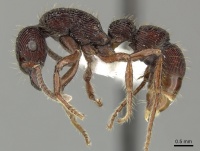Gnamptogenys volcano
| Gnamptogenys volcano | |
|---|---|

| |
| Scientific classification | |
| Kingdom: | Animalia |
| Phylum: | Arthropoda |
| Class: | Insecta |
| Order: | Hymenoptera |
| Family: | Formicidae |
| Subfamily: | Ectatomminae |
| Tribe: | Ectatommini |
| Genus: | Gnamptogenys |
| Species: | G. volcano |
| Binomial name | |
| Gnamptogenys volcano Lattke, 1995 | |
Nothing is known about the biology of Gnamptogenys volcano.
Identification
A member of the volcano complex (in the ericae subgroup of the sulcata species group).
Gnamptogenys volcano is close to Gnamptogenys sulcata but the latter can be recognized by the longitudinal costulae on the propodeal declivity, broader head, rounded mandibular basal angle with no tooth and the straight clypeal lamella with acutely angulate sides. The structure of the clypeal lamella, mesepisternum, and mandible make this a striking species within the sulcata group. (Lattke 1995)
Keys including this Species
Distribution
Latitudinal Distribution Pattern
Latitudinal Range: 10.28333333° to 9.8712602°.
| North Temperate |
North Subtropical |
Tropical | South Subtropical |
South Temperate |
- Source: AntMaps
Distribution based on Regional Taxon Lists
Neotropical Region: Costa Rica (type locality).
Distribution based on AntMaps
Distribution based on AntWeb specimens
Check data from AntWeb
Countries Occupied
| Number of countries occupied by this species based on AntWiki Regional Taxon Lists. In general, fewer countries occupied indicates a narrower range, while more countries indicates a more widespread species. |

|
Estimated Abundance
| Relative abundance based on number of AntMaps records per species (this species within the purple bar). Fewer records (to the left) indicates a less abundant/encountered species while more records (to the right) indicates more abundant/encountered species. |

|
Biology
|
Castes
Nomenclature
The following information is derived from Barry Bolton's Online Catalogue of the Ants of the World.
- volcano. Gnamptogenys volcano Lattke, 1995: 191, figs. 64, 65 (w.) COSTA RICA.
- Type-material: holotype worker.
- Type-locality: Costa Rica: Heredia, 18 km. N Volcán Barba, 10°17’N, 84°05’W, 800 m., 4-14.vii.1986, no. 1383-5 (J. Longino).
- Type-depository: LACM.
- Status as species: Lattke, et al. 2007: 262 (in key); Camacho, et al. 2020: 460 (in key); Camacho, Franco, Branstetter, et al. 2022: 11.
- Distribution: Costa Rica.
Unless otherwise noted the text for the remainder of this section is reported from the publication that includes the original description.
Description
Worker
Holotype measurements: HL 1.38; ML 0.55; HW 1.18; ED 0.25; SL 1.18; WL 1.93 mm; CI 0.86; SI 1.00; OI 0.21.
Head in frontal view elongate, vertexal margin concave; eyes prominent and situated at mid-length; clypeal lamella relatively long, laterally rounded and medianly concave; mandibles smooth and shining, with prominent piligerous fossae; subtriangular basal angle preceded by a tooth and concavity (or notch); scape when laid back barely surpasses vertexal margin; mesosomal dorsum with longitudinal costulae and propodeal declivity with transverse costulae, in dorsal view the costulae arch posterad and become longitudinal; gaster with longitudinal costulae, including postpetiolar sternum, weakly effaced anteromedianly; metacoxae with dorsobasal tooth, dorsally with transverse costulae and laterally mostly smooth and shining; subpetiolar process with no posterior heel; tibiae and femora smooth and shining. Body with numerous standing golden hairs; body brown, legs and antennae reddish brown.
Type Material
Holotype worker. Costa Rica, Heredia: 18 km Volcan Barba, 10°17'N 84°05'W, 800m, 4/14-VII-1986, J. Longino no. 1383-5. Wet forest litter sample. Deposited in Los Angeles County Museum of Natural History. One antenna lacking.
Etymology
The name of the species comes from the latin word for volcano, as the type locality is near the Barbas volcano.
References
- Cantone S. 2018. Winged Ants, The queen. Dichotomous key to genera of winged female ants in the World. The Wings of Ants: morphological and systematic relationships (self-published).
- Lattke, J.E., Fernández, F. & Palacio, E.E. 2007. Identification of the species of Gnamptogenys Roger in the Americas (pp. 254-270). In Snelling, R.R., Fisher, B.L. & Ward, P.S. (eds). Advances in ant systematics: homage to E.O. Wilson – 50 years of contributions. Memoirs of the American Entomological Institute 80: 690 pp.
- Lattke, J. E. 1995. Revision of the ant genus Gnamptogenys in the New World (Hymenoptera: Formicidae). J. Hym. Res. 4: 137-193. PDF(page 191, figs. 64, 65 worker described)
References based on Global Ant Biodiversity Informatics
- Fernández F., and T. M. Arias-Penna. 2008. Las hormigas cazadoras en la región Neotropical. Pp. 3-39 in: Jiménez, E.; Fernández, F.; Arias, T.M.; Lozano-Zambrano, F. H. (eds.) 2008. Sistemática, biogeografía y conservación de las hormigas cazadoras de Colombia. Bogotá: Instituto de Investigación de Recursos Biológicos Alexander von Humboldt, xiv + 609 pp.
- Longino J. T. L., and M. G. Branstetter. 2018. The truncated bell: an enigmatic but pervasive elevational diversity pattern in Middle American ants. Ecography 41: 1-12.
- Longino J. T., and R. K. Colwell. 2011. Density compensation, species composition, and richness of ants on a neotropical elevational gradient. Ecosphere 2(3): 16pp.
- Longino J. et al. ADMAC project. Accessed on March 24th 2017 at https://sites.google.com/site/admacsite/

